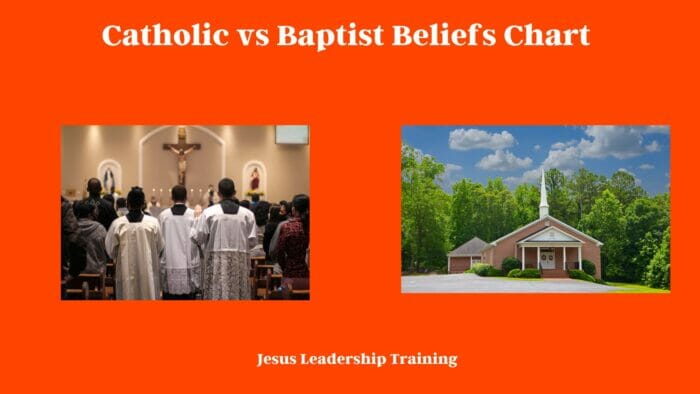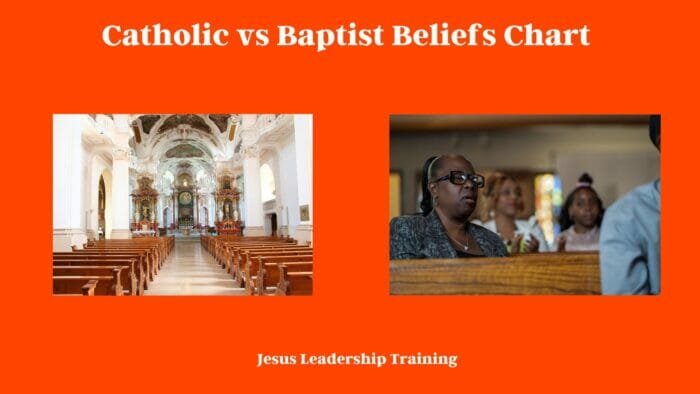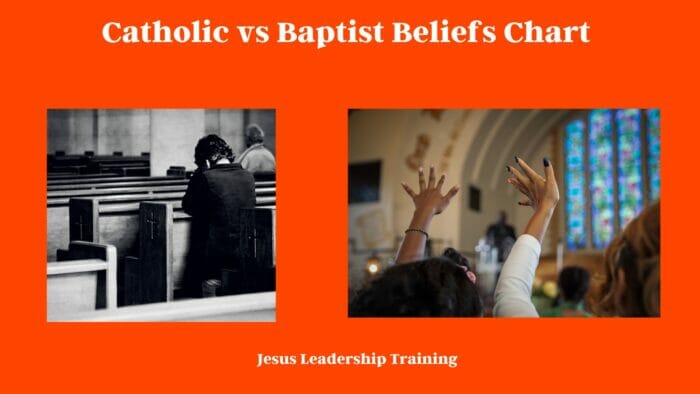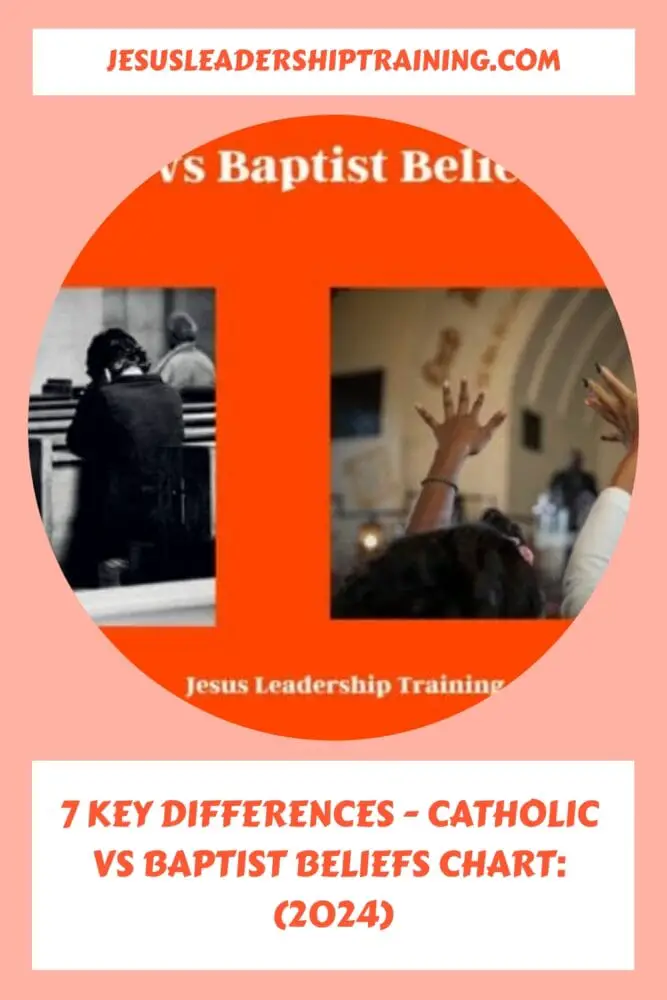Discover the nuanced contrasts and comparisons between Catholic and Baptist beliefs. Our Catholic vs Baptist beliefs chart offers a comprehensive guide to understanding these two major Christian denominations.
In the vast realm of Christianity, various denominations hold to distinct doctrines, rituals, and traditions. Two of the major branches are the Catholic and Baptist denominations. While both share a belief in Jesus Christ and the Bible, there are significant differences between them. This article provides a detailed “Catholic vs Baptist beliefs chart”, offering a bird’s-eye view into the core differences and similarities between the two denominations.
Table of Contents
Catholic vs Baptist Beliefs Chart: An Overview
The primary differences between Catholic and Baptist beliefs lie in their views on authority, sacraments, and the nature of salvation. Let’s dive deep into these differences to provide clarity and understanding.
1. Authority in the Church
- Catholic Perspective: Catholics believe in the papal authority, where the Pope, as the Bishop of Rome, holds a significant place as the earthly head of the church.
- Baptist Perspective: Baptists emphasize the autonomy of the local church. They don’t adhere to a centralized authority figure like the Pope.

2. The Role of Sacraments
- Catholic Standpoint: Catholics observe seven sacraments, including Baptism, Confirmation, and Eucharist, which are essential for one’s spiritual journey and salvation.
- Baptist Standpoint: Baptists mainly recognize two ordinances – Baptism and the Lord’s Supper. These aren’t seen as essential for salvation but as symbols of faith.
3. Nature of Salvation
- Catholic View: Catholics believe in faith complemented by works. Participation in the sacraments, good deeds, and adhering to church teachings play roles in one’s salvation.
- Baptist View: Baptists emphasize salvation by faith alone, solely through the grace of God and one’s personal relationship with Jesus Christ.
Chart Comparing the Similarities and Differences Between Catholics and Baptists
| Aspect | Catholic | Baptist |
|---|---|---|
| Foundation | One of the earliest Christian denominations tracing its roots back to Jesus and the Apostles. | Emerged during the Reformation in the 16th century. |
| Authority | The Pope serves as the spiritual leader. The Magisterium (teaching authority) provides guidance alongside the Bible. | Emphasizes the sole authority of the Bible. The local church is autonomous without a centralized figure like the Pope. |
| Sacraments/Ordinances | Recognizes seven sacraments: Baptism, Confirmation, Eucharist, Reconciliation, Anointing of the Sick, Holy Orders, and Matrimony. | Primarily recognizes two ordinances: Baptism and the Lord’s Supper. |
| Nature of Salvation | Believes in faith complemented by works. Sacraments and good deeds, along with faith, are essential for salvation. | Salvation is by faith alone, focusing on a personal relationship with Jesus and God’s grace. |
| Worship Style | Liturgical pattern with structured services based on the church calendar. | More spontaneous and less liturgical, often focusing on Bible teachings and personal experiences. |
| Communion | Believes in transubstantiation, where bread and wine become the actual body and blood of Christ during the Eucharist. | Views the elements of Communion symbolically. The bread and wine/juice represent Christ’s body and blood but don’t transform. |
| Baptism | Practices infant baptism. Believes baptism cleanses original sin and initiates the individual into the Church. | Baptism is for believers who’ve made a personal decision to accept Christ, often through full immersion. |
| Mary & Saints | Venerates Mary and believes in her Immaculate Conception. Saints are revered and can intercede for believers. | Respects Mary as Jesus’s mother but doesn’t venerate her. Saints are seen as role models but aren’t prayed to. |
| Clergy | Has priests and bishops who take vows of celibacy. | Has pastors or ministers. There’s no mandate for celibacy among the clergy. |
Both denominations, despite their differences, belong to the broader Christian faith and believe in the Holy Trinity, the divinity of Jesus Christ, and the Bible as the inspired word of God. Their shared goal is the spiritual enlightenment and salvation of their believers.

Ceremonies and Worship Styles
When attending services in Catholic and Baptist churches, one will quickly notice variations in the ceremonies and overall worship experience.
4. Liturgical vs Non-liturgical
- Catholic Worship: Catholics follow a liturgical pattern, which means the service is structured and follows a set order, primarily based on the church calendar.
- Baptist Worship: Baptist services are more spontaneous and less liturgical, often focusing on Bible teachings and personal experiences.
Here’s a table outlining the differences in worship styles between Baptist and Catholics:
| Aspect of Worship | Catholic | Baptist |
|---|---|---|
| Service Structure | Follows a liturgical pattern with a structured order, primarily based on the church calendar. | Typically non-liturgical with a more spontaneous structure. Services often revolve around Bible teachings and personal experiences. |
| Scripture Reading | Lectionary-based; predetermined readings from the Old Testament, New Testament, Psalms, and Gospels rotate on a three-year cycle. | Less structured in terms of scripture selection. Pastors often choose passages relevant to a particular sermon or theme. |
| Music and Hymns | Traditional hymns are prevalent. In recent years, contemporary Catholic worship music has been integrated into some services. | Mix of traditional hymns and contemporary Christian music. Worship bands and choirs are common in many Baptist churches. |
| Communion | Celebrated at every Mass. Believes in transubstantiation, where the bread and wine become the actual body and blood of Christ. | Usually observed monthly or quarterly. The bread and wine/juice are symbolic representations of Christ’s body and blood. |
| Prayers | Often recite established and communal prayers like the Lord’s Prayer, Hail Mary, and the Nicene Creed. | More emphasis on extemporaneous and personal prayers. Communal prayers like the Lord’s Prayer are also used. |
| Sermon | Homily is based on the scripture readings of the day and is generally shorter. | Sermon is central to the worship service and can be extensive, focusing on in-depth Bible teaching or topical issues. |
| Dress Code | Traditionally, attendees dress in formal attire, though this varies by region and culture. | Generally more relaxed dress code, but this can vary by church and region. |
| Symbols & Rituals | Use of incense, holy water, and liturgical vestments. Significant emphasis on the ritual aspect. | Less ritualistic. Emphasis on personal experiences and testimonials. |
It’s important to note that while these distinctions are generally accurate, there’s a lot of variation within each denomination depending on the region, culture, and individual congregations.

5. Communion Practices
- Catholic Tradition: The Eucharist, or Holy Communion, is celebrated at every Mass. Catholics believe in the transubstantiation where bread and wine become the body and blood of Christ.
- Baptist Tradition: Communion is seen symbolically. The bread and wine (or grape juice) are representations of Christ’s body and blood but don’t transform.
Here’s a detailed table outlining the differences in Communion styles between Baptist and Catholics:
| Aspect of Communion | Catholic | Baptist |
|---|---|---|
| Terminology | Often referred to as the “Eucharist” or “Holy Mass.” | Commonly called “Communion” or “The Lord’s Supper.” |
| Frequency | Celebrated at every Mass, which can be daily or at least weekly on Sundays. | Typically observed monthly or quarterly, though frequency can vary by congregation. |
| Theology | Believes in transubstantiation, meaning the bread and wine become the actual body and blood of Christ during consecration. | The bread and wine/juice are symbolic of Christ’s body and blood. They do not believe in any change in substance. |
| Bread | Typically unleavened wafers or hosts. | Can vary – some use unleavened bread, while others might use regular bread, broken into pieces. |
| Wine/Juice | Fermented wine. | Typically grape juice, especially in American Baptist churches. |
| Distribution Method | Administered by the priest or deacon. The congregation typically lines up and receives communion at the altar. In some places, attendees may kneel at a communion rail. | Often passed around in trays to seated congregants. Congregants may also walk to the front to receive elements. |
| Recipients | Only baptized Catholics in a state of grace (i.e., free from mortal sin) should receive. Some exceptions for other Christians exist but are rare. | Typically, all believers present who have professed faith in Christ are invited to partake, regardless of denomination. |
| Storage | Any leftover consecrated hosts are stored in the Tabernacle, a special gold box. Used wine is consumed by the priest or deacon. | Leftovers are treated without special rituals since they remain symbolic. |
| Significance | Seen as a re-presentation of Christ’s sacrifice on the cross. The Eucharist is central to Catholic theology and worship. | Commemorates the Last Supper and Christ’s sacrifice. It’s a time for reflection, remembrance, and personal examination. |
Keep in mind that practices and beliefs can vary within the broader categories of “Catholic” and “Baptist” based on specific congregations, regions, and cultural practices.
Beliefs about Mary and Saints
6. Veneration vs Admiration
- Catholic Beliefs: Catholics venerate Mary and believe in her Immaculate Conception. Saints are revered and can intercede for believers.
- Baptist Beliefs: Baptists respect Mary as the mother of Jesus but don’t venerate her. Saints are seen as role models but aren’t prayed to.
The Baptism Ritual
7. Infants vs Believers
- Catholic Practice: Catholics practice infant baptism. The ritual cleanses the original sin and marks the entry into the Church.
- Baptist Practice: Baptists perform baptism for believers who’ve made a conscious decision to accept Christ. It’s often done through full immersion.
Here’s a table detailing the differences in Baptism styles between Baptist and Catholics:
| Aspect of Baptism | Catholic | Baptist |
|---|---|---|
| Terminology | Often referred to as “Baptism.” | Commonly called “Believer’s Baptism.” |
| Age of Baptism | Infants are baptized. Adult baptisms occur, especially during the Easter Vigil for those joining the Church. | Baptism occurs after an individual has made a personal decision to accept Christ, typically at an age of understanding. |
| Mode of Baptism | Sprinkling or pouring of water over the head. | Full immersion in water, where the individual is fully submerged. |
| Formal Process | Includes the anointing with oil, lighting of the baptismal candle, and wearing a white garment. Godparents are selected for the baptized individual. | Often accompanied by the individual’s testimony. After the baptism, there’s typically a celebration or a certificate given. |
| Theological Significance | Believed to cleanse original sin and marks the initiation of the individual into the Church. | Symbolizes the believer’s death to sin and resurrection in Christ. Represents a public declaration of faith. |
| Recipients | Baptism is open to all, and it’s a sacrament that’s necessary for salvation, according to Catholic doctrine. | Only those who have consciously accepted Jesus as their Savior and can understand the significance of baptism are recipients. |
| Confirmation/Profession of Faith | A separate sacrament, usually in adolescence, where the baptized individual confirms their faith. | The act of baptism itself is seen as a profession of faith, and there’s no separate sacrament or ceremony. |
| Re-baptism | Catholics believe in one baptism for the remission of sins and typically don’t rebaptize. In cases where validity is in doubt, a conditional baptism might be performed. | Some Baptist churches may baptize individuals who were baptized as infants in other denominations, as they believe in baptizing only those who can profess their faith. |
As always, while these generalizations hold for many Catholic and Baptist congregations, practices can differ based on specific traditions, congregations, regions, and individual beliefs.
Catholic vs Baptist Beliefs Chart
FAQs
How do Catholics and Baptists view the Bible?
Both denominations see the Bible as the inspired Word of God. However, Catholics also rely on Church traditions and the Magisterium (teaching authority) for guidance, while Baptists prioritize the Bible’s authority.
What are the core similarities between Catholics and Baptists?
Both believe in the Holy Trinity, the resurrection of Jesus, and the importance of evangelism.
Do Baptists have priests like Catholics?
No, Baptists have pastors or ministers, while Catholics have priests.
Why don’t Baptists pray to saints?
Baptists believe in the priesthood of all believers. They emphasize a direct relationship with God, negating the need for intercession by saints.
Are all Baptists against infant baptism?
Most Baptists advocate believer’s baptism. However, some Baptist denominations may have varying views.
Which denomination is older, Catholic or Baptist?
The Catholic Church traces its origins back to the apostolic times, making it one of the earliest Christian denominations. Baptists emerged during the Reformation in the 16th century.
- Catholic vs Baptist Beliefs Chart
Q: Is there a chart that outlines the differences between Catholic and Baptist beliefs?
A: While there are various resources available that compare Catholic and Baptist beliefs, it’s important to consult trusted sources or religious authorities for accurate information. - Catholic vs Baptist
Q: What are the key differences between Catholic and Baptist beliefs and practices?
A: Catholicism and Baptism differ in areas such as their views on sacraments, ecclesiastical hierarchy, worship practices, and interpretation of scripture. These distinctions can vary among different Catholic and Baptist denominations. - What’s the Difference Between Catholic and Baptist?
Q: Can you explain the fundamental differences between Catholicism and Baptism?
A: Some primary differences include Catholicism’s belief in the real presence of Christ in the Eucharist, a hierarchical priesthood, and veneration of Mary and saints, whereas Baptists emphasize believer’s baptism, congregational autonomy, and a symbolic view of the Lord’s Supper. - What’s the Difference Between Baptist and Catholic?
Q: How do Baptist and Catholic beliefs and practices differ from each other?
A: Baptists typically emphasize individual faith and believer’s baptism by immersion, while Catholics emphasize sacraments, apostolic succession, and a centralized church hierarchy led by the Pope. - What Is the Difference Between Catholic and Baptist?
Q: Can you provide an overview of the key differences between Catholic and Baptist beliefs?
A: Differences include beliefs about church authority, the role of tradition, views on baptism and the Eucharist, and the veneration of saints and Mary. - Differences Between Catholics and Baptists
Q: What are the primary theological and doctrinal differences between Catholics and Baptists?
A: Differences include views on authority, the role of tradition, the nature of the church, the interpretation of the Bible, and religious practices. - What Is the Difference Between Baptist and Catholic?
Q: How do Baptist and Catholic beliefs and practices contrast with each other?
A: Baptist churches emphasize individual faith, congregational autonomy, and a symbolic view of the Eucharist, while Catholicism emphasizes sacraments, a hierarchical priesthood, and the real presence of Christ in the Eucharist. - Baptist and Catholic Differences
Q: What are some of the key theological and practical differences between Baptists and Catholics?
A: These differences encompass aspects of church structure, liturgy, sacraments, and beliefs about salvation. - Biggest Difference Between Catholic and Baptist
Q: What is the most significant difference between Catholic and Baptist beliefs?
A: One of the most significant differences is the Catholic belief in the real presence of Christ in the Eucharist, which contrasts with the Baptist view of the Lord’s Supper as symbolic. - Differences Between Catholic and Baptist
Q: Can you summarize the main distinctions between Catholic and Baptist beliefs and practices?
A: Key differences revolve around ecclesiastical structure, sacraments, interpretations of the Bible, and views on Mary and saints.
Final Thoughts – Catholic vs Baptist Belief Chart
The “Catholic vs Baptist beliefs chart” serves as a roadmap to understanding these two significant Christian denominations. While differences exist, it’s crucial to remember the shared core beliefs and the unifying love for Jesus Christ. By understanding these differences, believers can foster a spirit of unity, respect, and love for one another.







